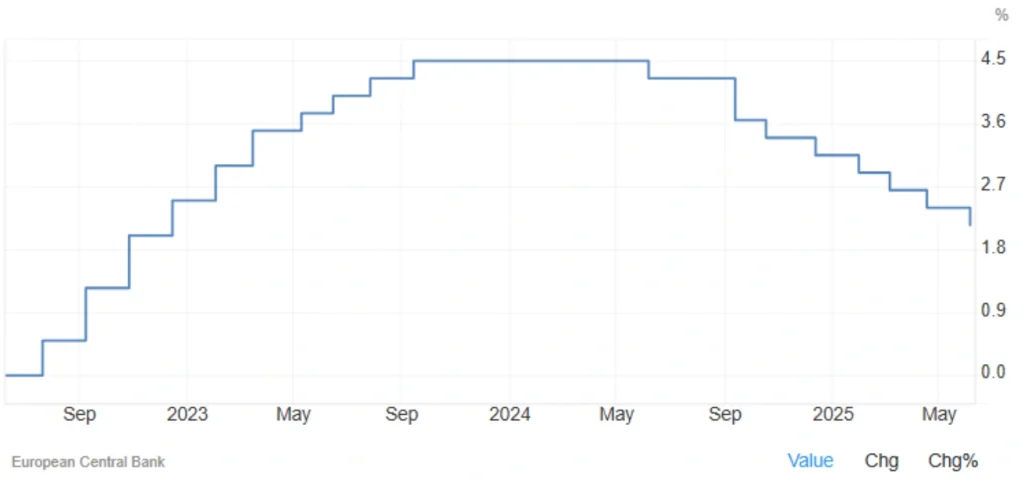
ECB Kicks Off Rate Cuts with a 25 Basis Point Move
In a highly anticipated move, the European Central Bank (ECB) has lowered its key interest rates by 25 basis points, marking the first step in a cautious shift away from its long-standing tightening cycle.
This decision, made during the ECB’s June 2025 meeting, reflects updated projections for inflation and growth in the eurozone economy.
Updated ECB Forecasts
| Indicator | 2025 | 2026 | 2027 |
|---|---|---|---|
| 🔺 Headline Inflation | 2.0% | 1.6% ⬇️ | 2.0% |
| 🔻 Core Inflation (ex food & energy) | 2.4% | 1.9% | 1.9% |
| 📊 GDP Growth | 0.9% | 1.1% ⬇️ | 1.3% |
Supporting Insights
- Wage growth remains elevated but is gradually slowing.
- Corporate profits have absorbed a large portion of cost pressures.
- Labor markets are still robust.
- Public investment continues to support economic activity.
- Trade tensions, especially with the U.S., remain a downside risk for exports and private investment.
Why Do ECB Interest Rate Decisions Matter?
ECB interest rates are the beating heart of eurozone monetary policy. They influence:
- 💰 Borrowing costs for consumers and businesses
- 📈 Returns on savings and deposits
- 💧 Liquidity flow through the economy
🔺 Higher rates = cooling inflation
🔻 Lower rates = boosting growth and spending

What Does the June Cut Tell Us?
The ECB’s 25bp cut marks the beginning of a cautious policy pivot. With headline inflation stabilizing near the 2% target and signs of softening in core inflation, the ECB now has room to begin easing without appearing reckless.
Yet, this doesn’t mean smooth sailing:
- ⚠️ Growth outlook is fragile: The eurozone faces ongoing trade uncertainty, especially from tighter U.S. policies and waning global demand.
- 📉 GDP forecasts for 2026 were revised downward, showing the ECB’s awareness of persistent headwinds.
On the flip side:
- ✅ Strong labor markets, improving real incomes, and steady public investment offer support.
- 🧾 Corporate profits continue to shield consumers from the full impact of wage-driven inflation.
Crucially, the ECB did not commit to a preset rate path. Instead, they emphasized a data-dependent approach, signaling that future decisions will hinge on actual inflation dynamics, wage trends, and trade developments.
Read More: Eurozone Inflation Falls Below ECB Target Since 2024
Summary
The ECB’s June 2025 decision signals the start of a new monetary phase—a careful entry into the rate-cut era as Europe walks a tightrope between managing inflation and fending off stagnation.
For markets, the message is clear:
➡️ Watch core inflation, wage trends, and trade risks closely—they’ll shape the ECB’s roadmap for the second half of the year.
Share
Hot topics

Forex Day Trading: Strategies and Tips
Day trading in the forex market has a certain captivating energy that draws many traders, from complete beginners to experienced traders. It’s fast, vibrant, and full of possibilities. At the...
Read more




Submit comment
Your email address will not be published. Required fields are marked *